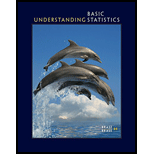
Concept explainers
Terminology Answer each of the following statements true or false regarding the level of significance a of a hypothesis test.
(i) The level of significance is the
(ii)The level of significance of a test depends on the value of the sample test statistic.
(iii)The level of significance is generally set in advance before samples are drawn.
(iv)The level of significance depends on the alternate hypothesis.
(v) The level of significance of a test depends on the
(i)
The statement “The level of significance is the probability of rejecting the null hypothesis when it is in fact true.” is true or false.
Answer to Problem 1CR
Solution: The statement “The level of significance is the probability of rejecting the null hypothesis when it is in fact true.” is true.
Explanation of Solution
The level of significance is the probability of rejecting the null hypothesis when it is in fact true is true. This is the probability of type I error when we reject the null hypothesis.
(ii)
The statement “The level of significance of a test depends on the value of the sample test statistic.” is true or false.
Answer to Problem 1CR
Solution: The statement “The level of significance of a test depends on the value of the sample test statistic.” is false.
Explanation of Solution
The level of significance is determined by the researcher before conducting the experiment. The significance level decides whether to reject the alternate hypothesis or not. Hence the level of significance of a test does not depend on the value of the sample test statistic.
(iii)
The statement “The level of significance is generally set in advance before samples are drawn.” is true or false.
Answer to Problem 1CR
Solution: The statement “The level of significance is generally set in advance before samples are drawn.” is true.
Explanation of Solution
The level of significance is determined by the researcher before conducting the experiment. The significance level decides whether to reject the alternate hypothesis or not. Hence the statement “The level of significance is generally set in advance before samples are drawn.” is true.
(iv)
The statement “The level of significance depends on the alternate hypothesis.” is true or false.
Answer to Problem 1CR
Solution: The statement “The level of significance depends on the alternate hypothesis” is false.
Explanation of Solution
The level of significance is determined by the researcher before conducting the experiment. The significance level decides whether to reject the alternate hypothesis or not. The statement “The level of significance depends on the alternate hypothesis” is false.
(v)
The statement “The level of significance of a test depends on the sample size.” is true or false.
Answer to Problem 1CR
Solution: The statement “The level of significance of a test depends on the sample size.” is false.
Explanation of Solution
The level of significance is determined by the researcher before conducting the experiment. The significance level decides whether to reject the alternate hypothesis or not. The statement “The level of significance of a test depends on the sample size.” is false.
Want to see more full solutions like this?
Chapter 9 Solutions
Understanding Basic Statistics
- A company found that the daily sales revenue of its flagship product follows a normal distribution with a mean of $4500 and a standard deviation of $450. The company defines a "high-sales day" that is, any day with sales exceeding $4800. please provide a step by step on how to get the answers in excel Q: What percentage of days can the company expect to have "high-sales days" or sales greater than $4800? Q: What is the sales revenue threshold for the bottom 10% of days? (please note that 10% refers to the probability/area under bell curve towards the lower tail of bell curve) Provide answers in the yellow cellsarrow_forwardFind the critical value for a left-tailed test using the F distribution with a 0.025, degrees of freedom in the numerator=12, and degrees of freedom in the denominator = 50. A portion of the table of critical values of the F-distribution is provided. Click the icon to view the partial table of critical values of the F-distribution. What is the critical value? (Round to two decimal places as needed.)arrow_forwardA retail store manager claims that the average daily sales of the store are $1,500. You aim to test whether the actual average daily sales differ significantly from this claimed value. You can provide your answer by inserting a text box and the answer must include: Null hypothesis, Alternative hypothesis, Show answer (output table/summary table), and Conclusion based on the P value. Showing the calculation is a must. If calculation is missing,so please provide a step by step on the answers Numerical answers in the yellow cellsarrow_forward

 College Algebra (MindTap Course List)AlgebraISBN:9781305652231Author:R. David Gustafson, Jeff HughesPublisher:Cengage Learning
College Algebra (MindTap Course List)AlgebraISBN:9781305652231Author:R. David Gustafson, Jeff HughesPublisher:Cengage Learning Glencoe Algebra 1, Student Edition, 9780079039897...AlgebraISBN:9780079039897Author:CarterPublisher:McGraw Hill
Glencoe Algebra 1, Student Edition, 9780079039897...AlgebraISBN:9780079039897Author:CarterPublisher:McGraw Hill Holt Mcdougal Larson Pre-algebra: Student Edition...AlgebraISBN:9780547587776Author:HOLT MCDOUGALPublisher:HOLT MCDOUGAL
Holt Mcdougal Larson Pre-algebra: Student Edition...AlgebraISBN:9780547587776Author:HOLT MCDOUGALPublisher:HOLT MCDOUGAL Functions and Change: A Modeling Approach to Coll...AlgebraISBN:9781337111348Author:Bruce Crauder, Benny Evans, Alan NoellPublisher:Cengage Learning
Functions and Change: A Modeling Approach to Coll...AlgebraISBN:9781337111348Author:Bruce Crauder, Benny Evans, Alan NoellPublisher:Cengage Learning




